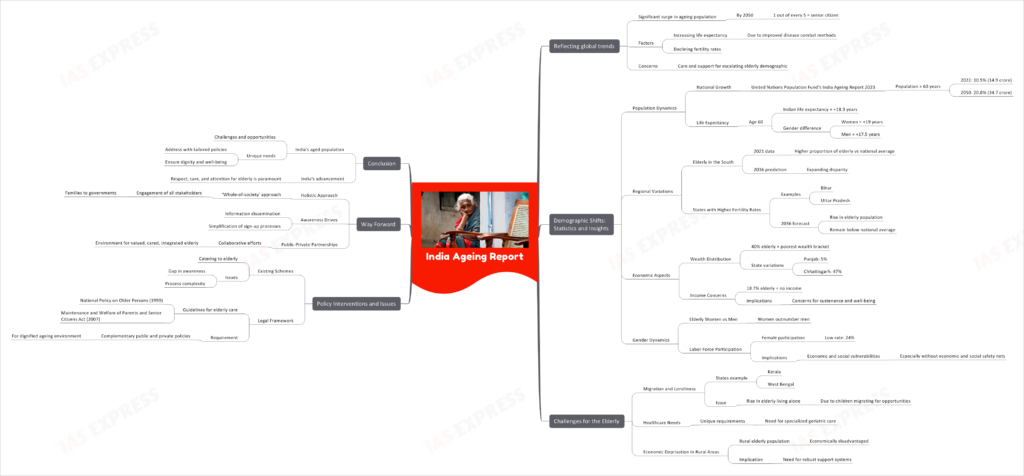India Ageing Report- How can India prepare for an Older Population?
India, reflecting global trends, is witnessing a significant surge in its ageing population. By 2050, one out of every five individuals in the nation is projected to be a senior citizen. The increasing life expectancy, thanks to improved disease combat methods, and declining fertility rates have sparked concerns regarding the care and support for the escalating elderly demographic.

Demographic Shifts: Statistics and Insights
Population Dynamics
- National Growth: The United Nations Population Fund’s India Ageing Report 2023 indicates that the population over 60 years of age will grow from 10.5% (14.9 crore) in 2022 to 20.8% (34.7 crore) by 2050.
- Life Expectancy: At the age of 60, an Indian can anticipate living an additional 18.3 years. Interestingly, the figures differ slightly between genders: women can expect 19 more years, while men have 17.5 more years.
Regional Variations
- Elderly in the South: In 2021, most southern states reported a higher proportion of elderly citizens than the national average. This disparity is predicted to expand further by 2036.
- States with Higher Fertility Rates: While states like Bihar and Uttar Pradesh will see a rise in their elderly population by 2036, they will still remain below the national average.
Economic Aspects
- Wealth Distribution: Over 40% of the elderly belong to the poorest wealth bracket. The range varies significantly among states, with Punjab at 5% and Chhattisgarh at 47%.
- Income Concerns: Around 18.7% of the elderly population does not possess any form of income, which raises major concerns for their sustenance and well-being.
Gender Dynamics
- Elderly Women Outnumbering Men: Among the senior citizen population, women are more in number than men.
- Labor Force Participation: Female labor force participation in India is quite low, recorded at just 24%. This could lead to increased economic and social vulnerabilities for women in their old age, especially if they lack sufficient social and economic safety nets.
Challenges for the Elderly
- Migration and Loneliness: States such as Kerala and West Bengal are witnessing a rise in elderly individuals living alone as their children move to other regions or countries in search of better opportunities.
- Healthcare Needs: Due to the unique healthcare requirements of the elderly, geriatric care must be adapted to cater specifically to them.
- Economic Deprivation in Rural Areas: A significant chunk of the rural population is both elderly and economically disadvantaged, emphasizing the need for more robust support systems.
Policy Interventions and Issues
- Existing Schemes: Numerous initiatives cater to the elderly, but there exists a gap in awareness or the process complexity that prevents efficient utilization.
- Legal Framework: The National Policy on Older Persons (1999) and the Maintenance and Welfare of Parents and Senior Citizens Act (2007) offer guidelines for elderly care. However, these need to be complemented by both public and private policies for an environment conducive to dignified ageing.
Way Forward
- Holistic Approach: Addressing the challenges requires a ‘whole-of-society’ approach, ensuring every stakeholder, from families to governments, plays their part.
- Awareness Drives: Disseminating information about existing schemes and simplifying the sign-up process can bridge the current knowledge gap.
- Public-Private Partnerships: Collaborative efforts can lead to an environment where the elderly feel valued, cared for, and integrated into the fabric of society.
Conclusion
The swelling aged population in India presents both challenges and opportunities. Addressing their unique needs with tailored policies and ensuring their dignity and well-being is not just a societal responsibility but also a testament to a nation’s maturity and compassion. As India advances, ensuring that its elderly are given the respect, care, and attention they deserve will be paramount.
Practice Question for Mains
Discuss the major findings of the India Ageing report. How can India prepare for an older population? (250 words)
If you like this post, please share your feedback in the comments section below so that we will upload more posts like this.

